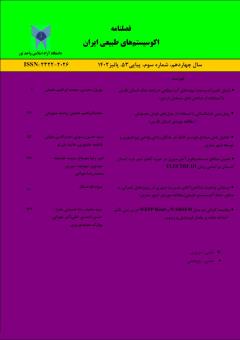پیشبینی خشکسالی با استفاده از مدل های هوش مصنوعی (مطالعه موردی استان فارس)
محورهای موضوعی : بیابان زدایی , GIS
محمد ابراهیم عفیفی
1
*
,
وحید سهرابی
2
![]()
1 - عضو هیات علمی گروه جغرافیا دانشگاه ازاد اسلامی واحد لارستان
2 - جغرافیا و برنامه ریزی شهری،دانشکده علوم انسانی،دانشگاه آزاد واحد لارستان،ایران
کلید واژه: خشکسالی, هوش مصنوعی, استان فارس,
چکیده مقاله :
گام ضروری برای مقابله با خشکسالی و تعدیل تبعات آن، شناخت و درک دقیق ابعاد آسیبپذیری هر منطقه است. این امر ضرورت مطالعه در زمینه تعیین آسیبپذیری و شناسایی عوامل اثرگذاربرآن در مناطق مختلف کشور را مشهودمیسازد درتحقیق حاضر، بهمنظو معرفی یک روش مناسب جهتپیشبینی خشکسالی برای یک ماه آتی، چهار روش هوش مصنوعی شامل یادگیری عمیق (از شبکه الکس نت که یکی از شبکههای کانولوشن است استفاده شده استالگوریتم K نزدیکترین همسایه، ماشین بردار پشتیبان چندطبقه و درخت تصمیم در نظر گرفته شد. دادههای بارندگی 11 ایستگاه سینوتیک استان فارس طی دوره آماری ۲۹ساله (1988 تا 2017) بهصورت ماهانه بهعنوان دادههای آزمایشی مورد استفاده قرار گرفتند. شاخص بارش استاندارد شده (SPI) برای نشاندادن وضعیت خشکسالی از نظر شدت و مدت در مقیاسهای زمانی 1، 3، 6، 9، 12 و ۲۴ماهه محاسبه گردید. در ابتدا دادههای بارش بهعنوان ورودی شبکههای عصبی و کلاسبندی شاخص بارش استاندارد شده بهعنوان خروجی شبکهها قرار داده شد. 80 درصد دادهها برای آموزش و 20 درصد دادهها برای تست شبکهها به کار گرفته شد. نتایج نشان داد که تمامی شبکهها توانایی پیشبینی خشکسالی را داشتهاند، بر اساس معیار ارزیابی ماکرو -f1 شبکه یادگیری عمیق در مقیاس زمانی ۱ماهه با 71/22 درصد، ناکارآمدترین روش و درخت تصمیم با 65/64 درصد، کارآمدترین روش بودهاند، اما با افزایش مقیاس زمانی، شبکه یادگیری عمیق عملکرد خود را بهبود بخشید، به طور یکه در مقیاس زمانی ۲۴ماهه با 35/65 درصد، بهترین عملکرد مربوط به شبکه یادگیری عمیق و بعد از آن، شبکه ماشین بردار پشتیبان با 40/57 درصد، قرار گرفت
Drought is one of the most costly natural disasters in Iran. The necessary step to deal with it and adjust its consequences is to know and understand the vulnerabilitydimensions of each region.The suitable method for predicting drought for the next month,four artificial intelligence methods including deep learning (Alexnet network is used, which is one of the convolution networks).K-nearest neighboralgorithm, multi-layer support vector machine and decision tree areconsidered.became.The monthly rainfall data of 11 synoptic stations of Fars province during a 29-year statistical period (1988 to 2017) were used as experimentaldata. The standardized precipitation index (SPI) was calculated to show the drought situation in terms of intensity and duration in time scales of 1, 3, 6, 9, 12 and 24 months. At first, the precipitation data was placed as the input of the neural networks and the classification of the standardized precipitation index was placed as the output of the networks. 80% of the data was used for training and 20% of the data was used for testing the networks. The results showed that all the networks had the ability to predict drought, based on the evaluation criteria of the macro-f1 deeplearningnetwork in the time scale of 1 month with 22.71%, the most inefficient method and the decision tree with 64.65%, the most efficient method, with increasing scale Over time, the deep learning network improved its performance, in the 24-month time scale, with 35.65%, the best performance related to the deep learning network, followed by the support vector machine network with 57.40%

